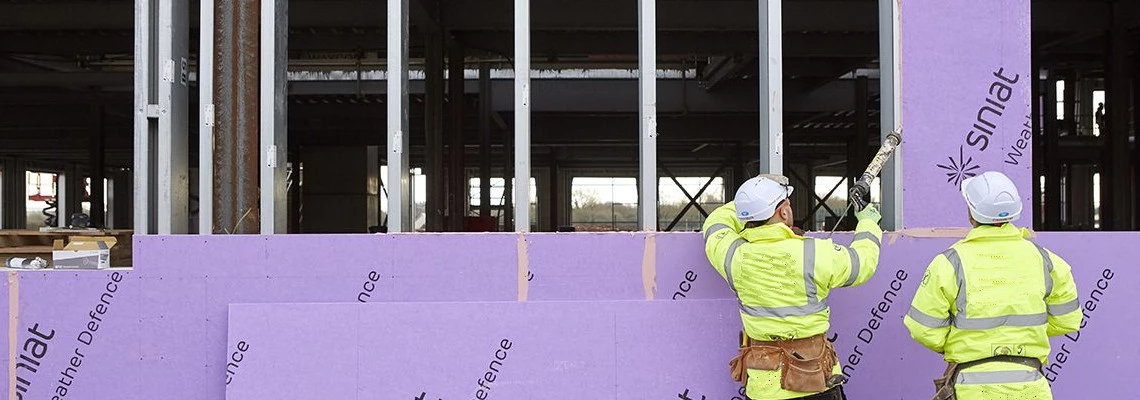
WHAT IS EXTERNAL SHEATHING BOARD? ǀ SHEATHING BOARD MEANING*
External sheathing board known as a construction board is an outer structural layer of the building wall used to strengthen the building structure and create a perfect base for siding or other finishing materials. It also protects against snow, wind and water penetration in order to keep building integrity and rigidity.
 TABLE OF CONTENTS
TABLE OF CONTENTS
WHAT IS EXTERNAL SHEATHING BOARD? ǀ SHEATHING BOARD MEANING
TYPES OF SHEATHING BOARDS
1. CEMENT BOARD
2. PLYWOOD
3. GYPSUM BOARD
4. ORIENTED STRAND BOARD (OSB)
SINIAT PURPLE SHEATHING BOARD. WHAT IS SO SPECIAL ABOUT THIS PRODUCT?
SHEATHING BOARDS THICKNESS
TYPES OF SHEATHING BOARDS
The materials most commonly used for sheathing include: cement board such as purple Siniat weather defence panel, plywood, gypsum and oriented strand board (OSB).
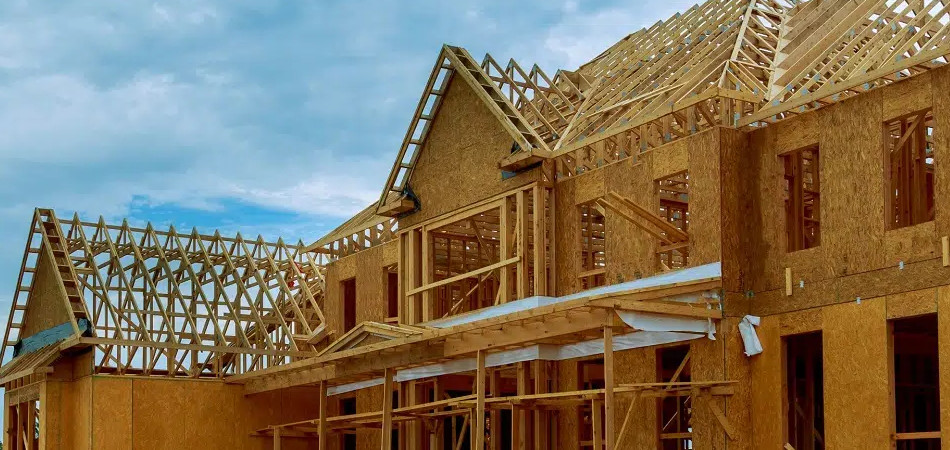
1.CEMENT BOARD
Cement board is a wall unit made from cement and reinforcing fibres that creates a sheet that attaches easily to a wall. Cement boards are non-combustible and are usually 1/2 inch thick measuring 2400mm x 1200mm (8'x 4') and can be used in numerous building applications such as base for ceramic tile, sheathing board or many other surface finishes, like paint or brick slips.
Because cement backer board is porous, grout, and mortar adhere well to it. Also cement board provides a stronger bond and support with tiles than typical gypsum board. Moreover, the unique cement formulation board offers great strength, stability and excellent acoustic properties. It has better long-term performance than paper-faced gypsum core products because it will not mildew or physically break down in the continued presence of moisture or leaks. It does not rot, warp, grow mould, or deteriorate when subjected to water. Can be nailed or screwed to wood or steel studs to create a substrate for vertical tile.
Cement boards are far heavier than gypsum boards and have one smooth face and one textured face, the smooth face should be fixed outermost. Boards can be found in a numerous other thicknesses such as 6mm, 9mm, 12mm and 15mm.
Major brands of cement boards are: Hardie backer, STS, Fassa, Cembrit, Siniat, Fermacell, Parex, Knauf and RCM.

CEMENT BOARDS PRODUCTS ǀ MANUFACTURERS
RCM Multipurpose Class A1 Fire Rated Cement Building Board
RCM RenderFlex Render Carrier Board Class A2
RCM Y-wall Class A1 Fire Rated Calcium Silicate Sheathing Board
RCM Cemboard Cement Bonded Particle Building Board
Parex Render Boards
Siniat BluClad Board
Fassa Externalight Render Board
Fermacell Powerpanel H2O
Cembrit Permabase Render Board
HardieBacker Backerboard
2. PLYWOOD
Plywood sheathing is made from lower density softwoods. Phenol formaldehyde (PF) is used as an adhesive in the manufacturing process. Plywood sheathing is made from whole sheets of wood that are cross-laminated, which give the boards strength and stiffness. This helps with expansion and contraction. Plywood is also about 15 - 19 % percent lighter than OSB. Plywood has good moisture resistance and dries fast.
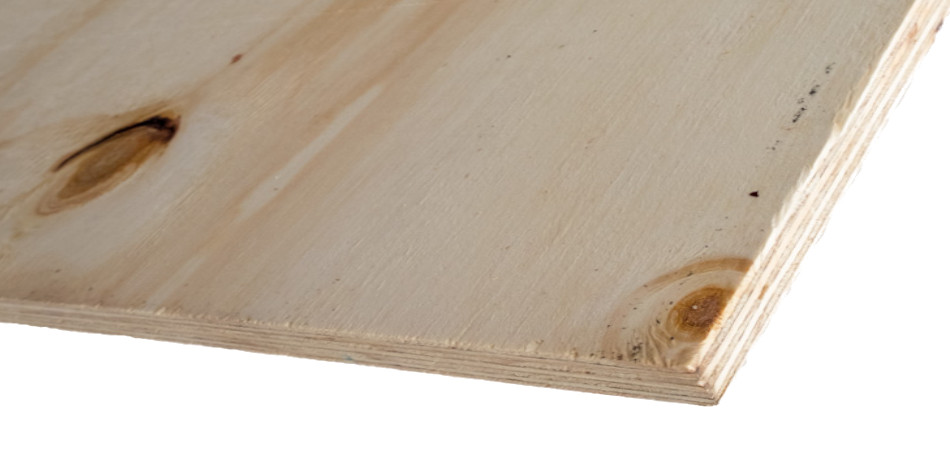
3. GYPSUM BOARD
Gypsum based structural sheathing is a panel-type material made up of a gypsum board with a glass fibre mat reinforcement which has inherent mould resistant properties. It is designed to provide temporary weather protection for a number of external structural frame
steel constructions where the façade/cladding system is fixed through the sheathing board into the structural frame steel stud.
Gypsum sheathing is fire-resistant, sound-reducing, durable, economical, and versatile. It is a reliable lightweight alternative to cement particle boards and is quick to install, without
the need for specialist cutting or dust extraction equipment, and with less mess
on site. Since it is free from cellulose content, it has a strong resistance to mould growth and water penetration, whilst also providing Euroclass A1 non-combustible reaction to fire performance. It provides up to 6 months of weather protection too .
Compared to cement particle boards, gypsum boards are lightweight weighing 10.9kg/m2. This equates to a weight reduction of approximately 35%, resulting in a product that is easier to handle and install, especially when working at height.
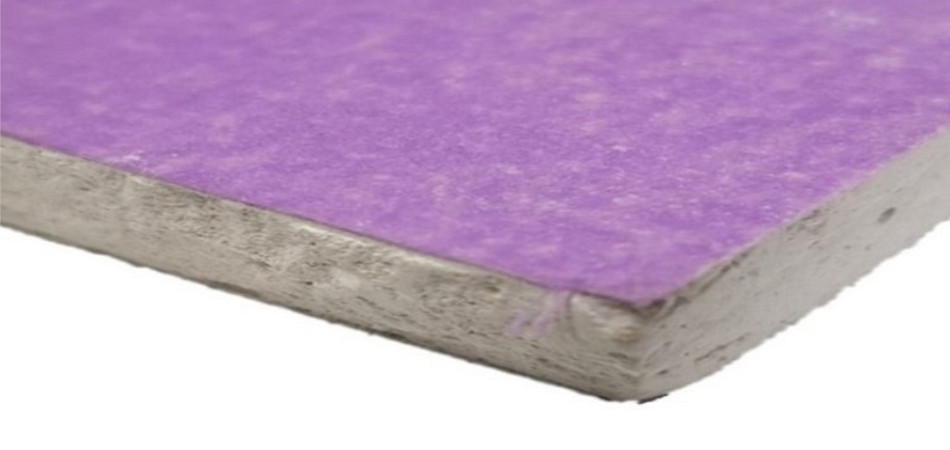
GYPSUM BOARDS PRODUCTS ǀ MANUFACTURERS
British Gypsum Glasroc X
Siniat Weather Defence
Klasse G-board
4. ORIENTED STRAND BOARD (OSB)
OSB wood sheet is manufactured by use of adhesives and layers of strands of wood (hence the name). It is these strands that give OSB its unique appearance. OSB sheet is a strong, versatile and reliable engineered sheet material designed to be used in a myriad of applications such as flooring and roofing, especially in areas of high humidity. As such, OSB is commonly used as sheathing materials on floors, ceilings and walls in today’s construction.
OSB is also used as an alternative to softwood plywood since it offers the same performance, but cheaper than plywood.
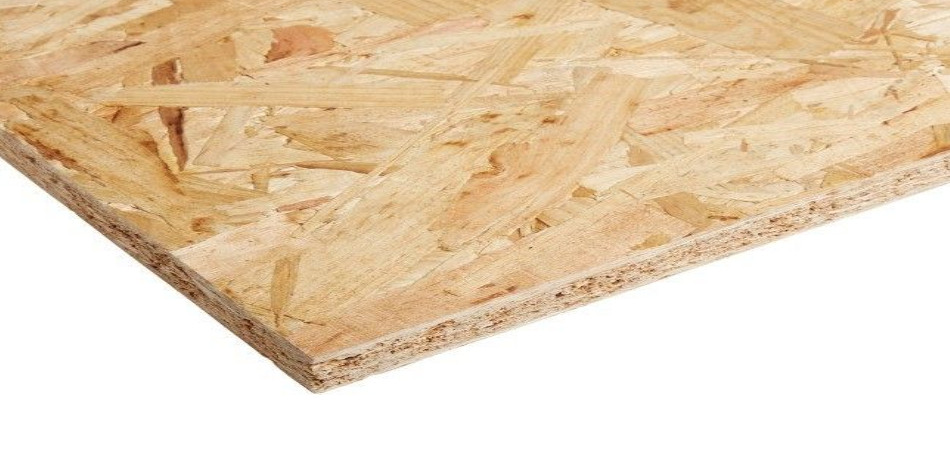
SINIAT PURPLE SHEATHING BOARD. WHAT IS SO SPECIAL ABOUT THIS PRODUCT?
Have you ever wondered why a lot of the buildings being constructed have a purple sheathing board on the outside? Here is the answer.
Siniat Weather Defence™ is a revolutionary gypsum-based external sheathing board, faced with a water-resistant material. That is why this purple board is the award winning Siniat Weather Defence™. Moreover, this Weather Defence™ board has been specified by over 45% of AJ100 British Architects. It has an improved formula and allows the board to be installed and exposed on frame for twelve months during construction, providing more flexibility to the project timeline. Purple sheathing board is significantly quicker to install than cement particle board. It can eliminate the need for a breather membrane, taking a stage
out of the weather tightness process. Weather Defence™ weighs 10.8 kg/m2 which is 30% lighter than a cement particle board of the same thickness, making it easier to lift and move around site. When cutting, cement particle boards require an electrical circular saw with a sharp blade. In contrast, Weather Defence™ just requires a Stanley knife hand tool. The score and snap method used for Weather Defence™ generates minimal dust levels and doesn’t require a separate cutting area.
“The Weather Defence™ board is ideal because you can manual handle it with two people either end of the board, it’s quite lightweight, robust and easy to manoeuvre around site.”
Tyler Clark, Trainee Site Manager, Optimum Drywall Systems Ltd
Weather Defence™ both resists rain and moisture, and allows vapour to escape,
just like a breather membrane. Weather Defence™ is an extremely stable substrate and will only expand by fractions of a millimetre per mm as humidity changes. This means that gaps do not need to be left between boards. The board itself is also vapour open yet highly water resistant, allowing damaging moisture trapped within a wall to escape.
“The lighter weight of Weather Defence™ meant we could easily cut holes in situ without having to bring the board down to the ground each time. This sped up construction.”
Jurgen Mensinga, Director, Elite Cladding Systems
SHEATHING BOARDS THICKNESS
The most common sheathing thicknesses are 1.2cm (15/32 in) for plywood and 1.1 cm (7/16 in) for OSB. For residential construction, the building code requirement typically is for a rated sheathing panel of either OSB or plywood of 0.95 cm (3/8 in) thickness when sheathing is required, as for shear wall sections. The recommended minimum thickness of OSB panels for timber-frame walls is 12mm when the cells in the supporting frame measure up to 62.5cm on a side, and 15mm for frame members spaced up to 83.3cm apart.
Related articles:
The ultimate guide to render carrier boards
Cedral Cladding. Frequently Asked Questions
*All the information provided in the content published on Insulationgo blog is for informational and educational purposes only. Insulationgo LTD makes every effort to ensure the accuracy and timeliness of the content, but we do not assume any responsibility for any errors or omissions.
The information presented on this blog should not be considered as professional advice or a substitute for consulting relevant experts. Before making any purchase decisions or taking action based on the information presented here, it is strongly recommended to contact the product manufacturer directly to verify the details and ensure its suitability for your specific needs.
By using this blog, you acknowledge and agree that Insulationgo LTD shall not be held liable for any damages, losses, or inconveniences arising from the use or reliance on the information provided herein. This limitation of liability applies to all users of the blog, including but not limited to visitors, readers, and subscribers.










































































































